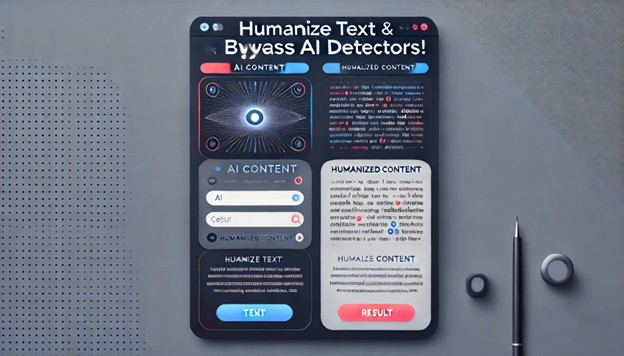In the modern digital era, the balance between efficiency and authenticity is crucial in content creation. Many professionals turn to tools like https://grubby.ai/ to generate high-quality material quickly. However, even the most advanced AI can produce text that feels mechanical or impersonal. Humanizing AI writing is all about transforming that output into content that meets human standards—making it relatable, engaging, and natural. This post explores various techniques and strategies for adjusting AI writing to fit human standards, enhancing relatability, polishing sentences, and ensuring that the process does not become overedited or lose the underlying message.
Adjusting AI writing to fit human standards
AI writing tools are designed to produce grammatically correct and factually accurate content, but they often lack the subtle nuances of human language. Adjusting AI writing to fit human standards involves several steps that go beyond simple grammar checks. To achieve a more natural tone, begin by evaluating the content for clarity, smooth transitions, and a conversational rhythm.
One effective approach is to consider the context in which your content will be read. For instance, an article for a professional audience might require a formal tone balanced with approachable language, whereas a blog post might benefit from a more relaxed, personal style. This contextual awareness helps in choosing the right vocabulary and sentence structures. Additionally, human writing typically incorporates a level of unpredictability that engages readers—something that AI-generated text sometimes lacks. By varying sentence lengths and introducing elements like rhetorical questions or idiomatic expressions, you can adjust the writing to better suit human readers.
Techniques for increasing relatability in text
Increasing relatability in AI-generated text is a critical part of humanizing the content. Relatable writing speaks directly to the reader, resonates with their experiences, and elicits an emotional response. One of the simplest yet most powerful techniques is to include real-world examples or personal anecdotes that make abstract ideas more concrete. When readers see familiar scenarios or share common challenges, the content feels more relevant and trustworthy.
Another valuable technique is to use a conversational tone. This means incorporating contractions, everyday language, and even humor where appropriate. A casual tone doesn’t undermine professionalism; instead, it builds a bridge between the author and the audience by making the text feel like a friendly conversation rather than a formal lecture. Additionally, addressing the reader directly—using words like “you” and “we”—can significantly increase relatability. These small touches can transform a generic piece of content into one that feels personalized and engaging.
Using storytelling elements is also essential. Start by setting a relatable context or problem, then guide the reader through a narrative that offers insights, solutions, or perspectives in a structured yet informal way. This storytelling technique not only conveys information effectively but also helps the reader connect emotionally with the content.
Steps to polish AI-generated sentences
Once you’ve adjusted the overall tone and introduced relatability into your text, the next phase is polishing the individual sentences. Polishing AI-generated sentences involves an iterative process of editing and refinement. Start by reading the text out loud. This practice helps detect awkward phrasing or abrupt transitions that might interrupt the natural flow of the narrative.
Next, focus on the rhythm and cadence of your sentences. Human writing tends to have a varied pace—some sentences are short and punchy while others are longer and more descriptive. Mixing these effectively can dramatically enhance readability. Look for areas where the AI may have repeated phrases or used similar sentence structures too frequently, and take the opportunity to rephrase those sections. Embrace creative language, vary punctuation, and consider integrating transitional words that add fluidity between thoughts.
Rewriting and restructuring paragraphs can also contribute to a more polished final product. Break down long paragraphs into more manageable chunks to ensure that each section communicates a single idea clearly. By refining both the micro and macro elements of your text, you create a seamless narrative that retains the original meaning but appears far more natural.
Avoiding overediting in humanizing AI content
While refining and polishing are essential steps in humanizing AI content, there is a fine line between effective editing and overediting. Overediting can strip the text of its natural voice, making it sound forced or overly contrived. The key is to maintain the original intent and energy of the content while enhancing its clarity and relatability.
To avoid overediting, it’s important to trust your instincts and let the text breathe. After multiple rounds of revisions, take a step back and re-read your work as if you were encountering it for the first time. Does it sound natural? Does the content still carry the message you intended? Sometimes, less is more. Allow some imperfections and organic flow to remain, as these are often the hallmarks of a genuine human touch.
Another practical tip is to set clear objectives for each round of editing. For the initial pass, focus solely on correcting glaring errors or awkward structures. In subsequent rounds, work on refining style and tone without altering the core message. This focused approach prevents you from getting lost in minutiae and preserves the original spirit of the text.
Collaboration can also be an effective way to avoid overediting. Sharing your draft with a trusted colleague or friend can provide fresh insights and help you strike the right balance between polish and authenticity. Peer feedback can highlight areas that feel excessively reworked, allowing you to restore natural elements that may have been lost in the editing process.
In conclusion, humanizing AI writing is both an art and a science. By adjusting AI output to meet human standards, using techniques to boost relatability, polishing sentences thoughtfully, and being cautious not to overedit, you can transform robotic content into engaging, authentic narratives. Leveraging tools and platforms like https://grubby.ai/ can streamline this process, offering initial drafts that, with the right human touch, become indistinguishable from organically written material. Embrace these methods to not only meet the needs of modern content consumers but also to make your writing resonate on a deeper, more personal level.
WATCH TOP VIDEOS FROM NIGERIAN TRIBUNE TV
- Let’s Talk About SELF-AWARENESS
- Is Your Confidence Mistaken for Pride? Let’s talk about it
- Is Etiquette About Perfection…Or Just Not Being Rude?
- Top Psychologist Reveal 3 Signs You’re Struggling With Imposter Syndrome
- Do You Pick Up Work-Related Calls at Midnight or Never? Let’s Talk About Boundaries







